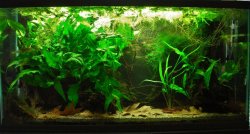I bought a used tank with stand, hood and light fixture, aquarium dimensions are 36" X 12" X 18" which is I believe is a 33 Gallon tank.
I get exited and the next day I went to petsmart and I get two amazon swords, one water sprite,one flame moss and a red and green plant with short leaves .I know made a mistake because I didn't read the plants requirements before I bought them. the guy at petsmart also recommended to buy some chemicals tablets for plants which I believe they are fertilizers ( I read the instructions on the bag and it says to put one tablet for each 15 cm radius ). my light fixture is 36" but the light fluorescent tube itself is 23.5" long. the lamp wattage is 17 Watt and I can't install more than one light tube in the hood. so basically myhttp /www.fishlore.com/fishdictionary/w.htm#WPG is 17/33 = ~0.5 WPG.
/www.fishlore.com/fishdictionary/w.htm#WPG is 17/33 = ~0.5 WPG.
After doing some research I found out that the http /www.fishlore.com/fishforum/aquarium-plant-profiles/119471-amazon-swords.html and the water sprite needs more than 2 WPG.
/www.fishlore.com/fishforum/aquarium-plant-profiles/119471-amazon-swords.html and the water sprite needs more than 2 WPG.
My questions:
1) Can i keep those plants without CO2 system ( I have no idea about CO2 and how it works)
2) Is my light enough to grow those plants (except the flame moss which I believe will do well with the current light)
3) if I have to upgrade my light, can I find a fluorescent tube lamp that is 30, 60 or 90 Watt without changing the whole hood.
I get exited and the next day I went to petsmart and I get two amazon swords, one water sprite,one flame moss and a red and green plant with short leaves .I know made a mistake because I didn't read the plants requirements before I bought them. the guy at petsmart also recommended to buy some chemicals tablets for plants which I believe they are fertilizers ( I read the instructions on the bag and it says to put one tablet for each 15 cm radius ). my light fixture is 36" but the light fluorescent tube itself is 23.5" long. the lamp wattage is 17 Watt and I can't install more than one light tube in the hood. so basically myhttp
 /www.fishlore.com/fishdictionary/w.htm#WPG is 17/33 = ~0.5 WPG.
/www.fishlore.com/fishdictionary/w.htm#WPG is 17/33 = ~0.5 WPG.After doing some research I found out that the http
 /www.fishlore.com/fishforum/aquarium-plant-profiles/119471-amazon-swords.html and the water sprite needs more than 2 WPG.
/www.fishlore.com/fishforum/aquarium-plant-profiles/119471-amazon-swords.html and the water sprite needs more than 2 WPG.My questions:
1) Can i keep those plants without CO2 system ( I have no idea about CO2 and how it works)
2) Is my light enough to grow those plants (except the flame moss which I believe will do well with the current light)
3) if I have to upgrade my light, can I find a fluorescent tube lamp that is 30, 60 or 90 Watt without changing the whole hood.




